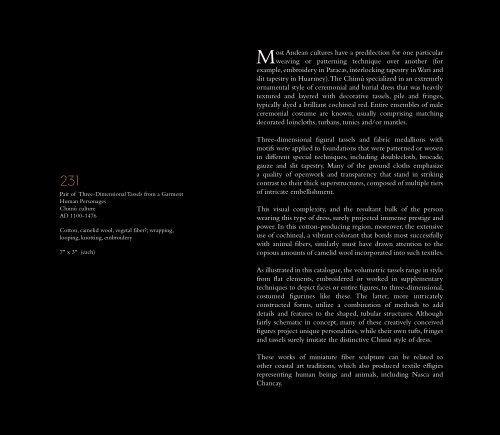You also want an ePaper? Increase the reach of your titles
YUMPU automatically turns print PDFs into web optimized ePapers that Google loves.
Most Andean cultures have a predilection for one particular<br />
weaving or patterning technique over ano<strong>the</strong>r (for<br />
example, embroidery in Paracas, interlocking tapestry in Wari and<br />
slit tapestry in Huarmey). The Chimú specialized in an extremely<br />
ornamental style of ceremonial and burial dress that was heavily<br />
textured and layered with decorative tassels, pile and fringes,<br />
typically dyed a brilliant cochineal red. Entire ensembles of male<br />
ceremonial costume are known, usually comprising matching<br />
decorated loincloths, turbans, tunics and/or mantles.<br />
231<br />
Pair of Three-Dimensional Tassels from a Garment<br />
Human Personages<br />
Chimú culture<br />
AD 1100-1476<br />
Cotton, camelid wool, vegetal fiber?; wrapping,<br />
looping, knotting, embroidery<br />
7" x 3" (each)<br />
Three-dimensional figural tassels and fabric medallions with<br />
motifs were applied to foundations that were patterned or woven<br />
in different special techniques, including doublecloth, brocade,<br />
gauze and slit tapestry. Many of <strong>the</strong> ground cloths emphasize<br />
a quality of openwork and transparency that stand in striking<br />
contrast to <strong>the</strong>ir thick superstructures, composed of multiple tiers<br />
of intricate embellishment.<br />
This visual complexity, and <strong>the</strong> resultant bulk of <strong>the</strong> person<br />
wearing this type of dress, surely projected immense prestige and<br />
power. In this cotton-producing region, moreover, <strong>the</strong> extensive<br />
use of cochineal, a vibrant colorant that bonds most successfully<br />
with animal fibers, similarly must have drawn attention to <strong>the</strong><br />
copious amounts of camelid wool incorporated into such textiles.<br />
As illustrated in this catalogue, <strong>the</strong> volumetric tassels range in style<br />
from flat elements, embroidered or worked in supplementary<br />
techniques to depict faces or entire figures, to three-dimensional,<br />
costumed figurines like <strong>the</strong>se. The latter, more intricately<br />
constructed forms, utilize a combination of methods to add<br />
details and features to <strong>the</strong> shaped, tubular structures. Although<br />
fairly schematic in concept, many of <strong>the</strong>se creatively conceived<br />
figures project unique personalities, while <strong>the</strong>ir own tufts, fringes<br />
and tassels surely imitate <strong>the</strong> distinctive Chimú style of dress.<br />
These works of miniature fiber sculpture can be related to<br />
o<strong>the</strong>r coastal art traditions, which also produced textile effigies<br />
representing human beings and animals, including Nasca and<br />
Chancay.







